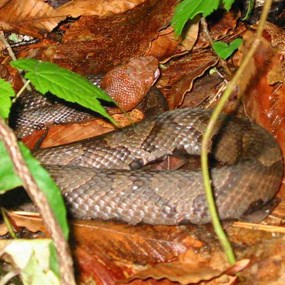|
While there are many different types of snakes found at New River Gorge National Park and Preserve, only two types are venemous; the Northern Copperhead and the Timber Rattlesnake. Although these snakes are not normally aggressive, they can bite if surprised or threatened. Copperheads and rattlesnakes are an essential part of the natural ecosystem and an important component in the natural food chain. Please remember that snakes are protected at New River Gorge National Park and Preserve; it is illegal to harm them.

Common Traits: The copperhead and the rattlesnake share three characteristics that can quickly distinguish them from other non-venomous snakes. 1. Broad, flattened, arrow shaped heads with narrow necks, while the heads of non venomous snakes are long and slender. 2. The venomous snakes have elliptical shaped eyes similar to a cat's eye, while non venomous snakes eyes are round. 3. Sensory pits located near the nostrils are also unique to venomous snakes. How to avoid being bitten:
First Aid for a Snake Bite:

Northern CopperheadDescription:
Habitat:
Characteristics:

Timber Rattlesnake:Description:
Habitat:
Characteristics:
|
Last updated: May 26, 2021
